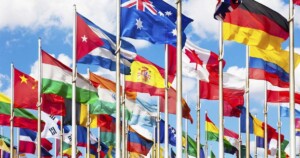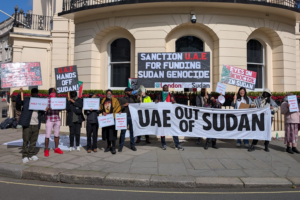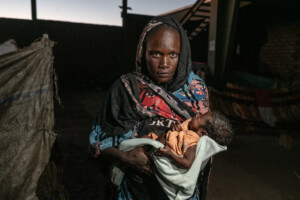Sudan OCHA bulletin 1: Thousands newly displaced from Jebel Marra
An estimated 2,200 people (about 440 families) arrived in Otash camp for the displaced near the South Darfur capital of Nyala from East Jebel Marra between 13 December 2018 and 7 January 2019 from East Jebel Marra locality, according to the Sudan government’s Humanitarian Aid Commission (HAC) and the International Organization for Migration (IOM).

An estimated 2,200 people (about 440 families) arrived in Otash camp for the displaced near the South Darfur capital of Nyala from East Jebel Marra between 13 December 2018 and 7 January 2019, according to the Sudan government’s Humanitarian Aid Commission (HAC) and the International Organization for Migration (IOM).
According to the latest bulletin of the UN Office for the Coordination of Humanitarian Affairs (OCHA) in Sudan, the displaced people had initially fled their homes in Gubu, Saboon El Fagur and Kawara villages to caves near Erri, Korobandra, Reimo and Kidila villages following fighting between the Sudan Liberation Movement-Abdelwahid El Nur (SLM-AW) and government forces between May and June 2018. They have had no access to shelter, water, food, health or security services. Their arrival at Otash camp is their second displacement. The newly displaced people have informed humanitarian partners about these details after their arrival in the camp as they were not previously accessible when they were initially displaced in mountainous villages.
The new arrivals said that they had consumed most of their food stocks and assets. With the current economic situation and increase in prices they are in dire need of humanitarian assistance. Safety and protection are another of their main concerns. They travelled at night due to security concerns on the road from East Jebel Marra locality to Otash camp. At the camp they would be able to access women protection networks and services through the women’s centre in the camp.

Newly displaced at Otash Camp in South Darfur, December 2018 (Photo: UN OCHA)
There was a joint Government-UN-INGO mission to Otash IDP camp to assess the needs of the new IDPs on 15 January. As part of the recommendations of the joint mission, on 24 January, IOM started the registration and verification of the new IDPs in the camp, which was finalized on 31 January. On 7 February, a total of 1,229 IDPs received food and non-food essential supplies, in addition to health, water, sanitation and hygiene (WASH) and nutrition services, which they were able to access upon arrival in the camp.
Recommendations from the team listed the following actions: IOM to follow up with the IDP tracking unit to report additional new arrivals; sectors to carry out in-depth assessments to determine sector-specific needs; health and nutrition partners to carry out nutrition screening for children under five as well as pregnant and lactating women and to refer any cases that need treatment; carrying out health, reproductive health, nutrition, water, sanitation and hygiene awareness-raising sessions; the UN Refugee Agency (UNHCR) to prepare a reception centre to accommodate new arrivals until they find shelter within the camp; UNHCR to accelerate the delivery of non-food items (NFIs) to the new arrivals; and to provide food assistance.
Sudan hosts the largest number of refugees from South Sudan
Sudan hosts the largest number of refugees from South Sudan in the region, while 2018 sees the lowest rate of South Sudanese refugee arrivals into the country since 2013, according to the UN Refugee Agency (UNHCR) portal on South Sudan refugee situation.
Over 33,100 South Sudanese refugees arrived in Sudan in 2018 bringing their total number in Sudan to 852,080 by the end of 2018, says UNHCR in their latest report. This marks the lowest rate of new arrivals per year since the start of the conflict in South Sudan in December 2013. Inter-agency partners estimate the arrival of up to 50,000 South Sudanese refugees in 2019.

UNHCR and COR staff registering newly arrived South Sudanese refugees in Khoral-Waral camp in White Nile State
(UNHCR, January 2019)
Refugee youth support children at-risk in White Nile State
Refugee Youth Committees in El Agaya and Dabat Bosin refugee camps in White Nile State are set to strengthen youth capacity to identify at-risk children and youth in the camps, and support service referrals and follow-up by the Youth Committees through new projects. Refugee youth will work to improve support to survivors of sexual and gender-based violence (SGBV) and roll-out campaigns in the camps about prevention of early pregnancy. These projects were developed with support from UNHCR’s Child Protection teams, and are planned to begin this year.
Protection initiative positively impacts on refugee community
The national NGO Nada El Azhar’s protection project—that was piloted in April 2018 with the support of UNHCR and ended in December 2018—has had a positive impact on the refugee community.
The NGO constructed three multi-purpose community centres to support protection outreach and established community-based protection networks for South Sudanese refugee women in El Laeit and El Fasher localities in North Darfur. The national NGO also distributed clothing to 300 refugee women and hygiene kits to 2,500 women in El Laeit, and initiated a multi-purpose cash-based pilot project for 30 refugee women-headed households in El Fasher.
The refugee community appreciated the interventions and asked for the project to continue. Nada El Azhar is working closely with UNHCR and refugee communities to build upon project gains with a follow-up project in 2019 planned.
South Sudanese children born in Sudan receive birth certificates
UNHCR, the Sudan Civil Registry and the Commission for Refugees (COR) on 28 January 2019 organized a joint celebration in El Redis 2 camp—the second largest camp for South Sudanese refugees in White Nile State—to mark the beginning of the distribution of the first batch of more than 3,300 birth certificates issued by the Civil Registry for South Sudanese refugee children born in Sudan. This birth registration exercise is important to achieve the Global Action Plan to end statelessness specifically among refugees and asylum-seekers due to the lack of adequate documentation.
The exercise follows an agreement signed in August 2018 between UNHCR and the Civil Registry to extend their regular practice of birth registration to communities in forced displacement.
Mary William, a 34-year-old refugee, said she is happy that her two-year old daughter Rimaz Abdallah was among 372 children who were registered and issued with birth certificates in El Redis 2 camp.
“I have been waiting for this day for more than a year. Without this certificate, I cannot prove that my daughter even exists and has a name. Now I feel at ease and she will be proud of me when she grows up,” William said.
This project has been made possible through the Asylum, Migration and Integration Fund (AMIF) and involves a partnership between UNHCR, UNICEF and the Royal Embassy of the Netherlands in the Sudan, working together to ensure the protection, registration and documentation of people in forced displacement and their hosting communities.
The AMIF was set up by the European Union (EU) with a total of EUR 3.137 billion (US$ 3.55 billion), to promote the efficient management of migration flows and the development and implementation of a common EU approach to asylum and immigration between 2014 and 2020.
Over 1,500 Ethiopian nationals arrive in eastern Sudan fleeing violence in Ethiopia
Over 1,500 Ethiopian citizens fled renewed inter-communal violence in western Ethiopia and sought refuge in eastern Sudan between 10 January and 2 February 2019, reports UNHCR.
Of the new arrivals, 1,344 said they would like to seek asylum in Sudan and were relocated to Shagarab refugee camp from El Fazra and Basunda localities in El Gedaref state. The new arrivals were registered by the COR and received food, water and medical assistance in the camp. UNHCR built temporary shelters for the arrivals and provided them with non-food items such as soap, blankets and kitchen sets. Some people expressed their willingness to return home and called on authorities and UNHCR to coordinate with the Ethiopian government their safe return. Another group of 126 people had already been provided with the necessary travel documents by the authorities for their return to Ethiopia. An additional 3,000 people could arrive in the country if fighting does not stop, the new arrivals said.

Ethiopians fleeing conflict arrive in Sudan (UNHCR, January 2019)
This is not the first time inter-communal disturbances resulted in the displacement of Ethiopian nationals into Sudan. In November 2018, about 1,200 people (1,068 Ethiopian and 104 Eritrean nationals) arrived in El Gedaref following inter-communal violence in parts of western Ethiopia bordering Sudan. Once the fighting stopped, 1,061 Ethiopian nationals were assisted to return back to Ethiopia, while seven people opted to seek asylum in Sudan. All the 104 Eritrean nationals who arrived have sought asylum in Sudan and were transferred to the Shagarab refugee camp in El Gedaref.
IPC projections on food security in the first quarter of 2019
From January to March 2019 the Integrated Food Security Phase Classification (IPC) projects that 5.76 million people will be in crisis and emergency (IPC Phases 3 and 4) levels of food insecurity, according to the latest Sudan: Acute Food Insecurity Situation October – December 2018 and Projection for January – March 2019 report. More than 1 million people will be in IPC Phase 4 (emergency) levels of food insecurity and more than 4.67 million people will be in IPC Phase 3 (crisis) levels, says IPC.
The report further says that 33 localities are estimated to be in IPC phase 3 (crisis) levels of food insecurity in South Kordofan, Kassala, El Gedaref, Red Sea, Blue Nile, White Nile, and Darfur states. In addition, Darfur accounts for about 45 per cent of the population reported as having crisis and emergency (IPC Phase 3 and IPC Phase 4) levels of food insecurity. The highest prevalence of population in crisis (IPC Phase 3) and emergency (IPC Phase 4) levels are in the states of Khartoum and South Darfur.
The main reasons behind the high levels of food insecurity can be attributed to the current economic challenges, which led to the devaluation of the Sudanese pound, high inflation rates, and increasing prices of food and non-food commodities, says IPC.
In addition, diminished household food stocks, especially in areas that suffer insecurity, conflicts and population mobility have also affected food availability at the household level. Livelihood coping strategies have been eroded and inadequate income generating opportunities do not allow households to fully cover their food gaps, IPC reports.











 and then
and then